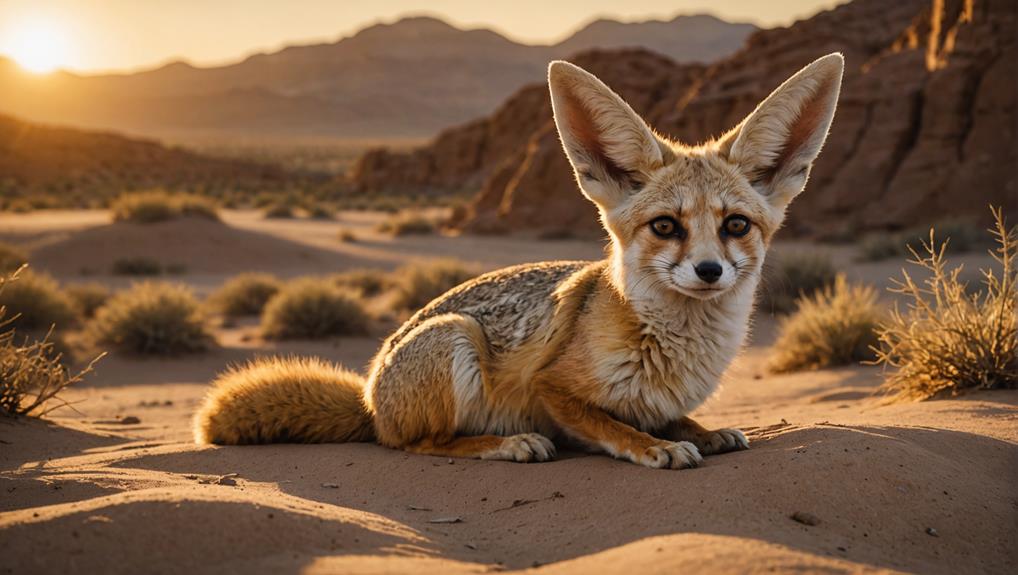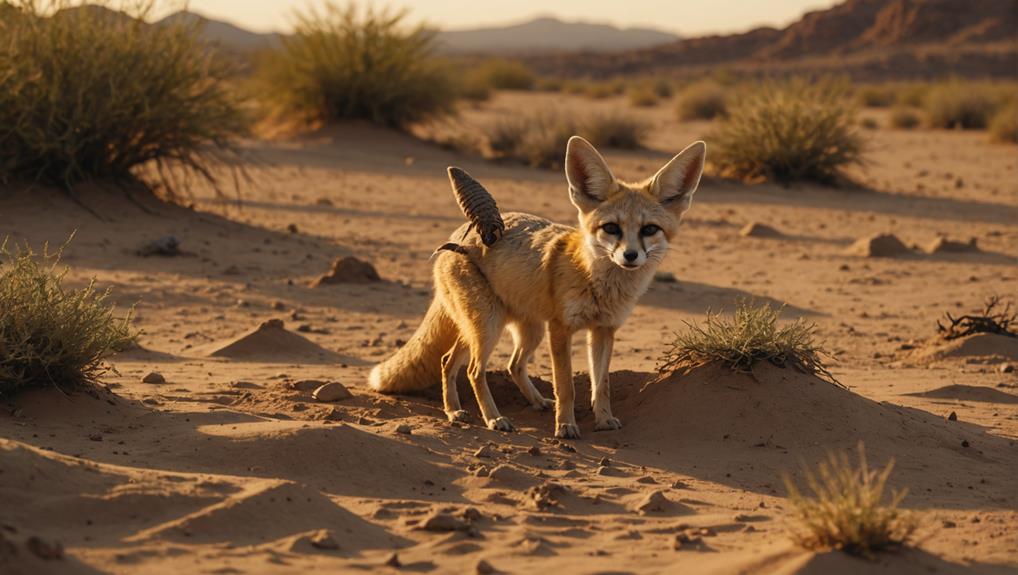The fennec fox rocks the desert with its clever habitat preferences! You'll find it active at night, which helps it dodge the heat. With those big ears, it hears prey scurrying beneath the sand while also cooling down. These little guys dig impressive burrows that can go 32 feet deep, providing shelter from the sun and sneaky predators. Not to mention, they get their moisture from food, not water—how resourceful! Socially, they form cute family groups, too. So, if you're curious about how they thrive despite challenges, stick around to discover more fascinating details!
Contents
Desert Adaptations
The fennec fox is a master of survival in the harsh desert environment. You see, this little creature has some incredible desert adaptations that help it thrive in the Sahara Desert and other arid regions.
First off, being nocturnal means it's out and about at night when temperatures are cooler, avoiding the scorching heat of the day. You can imagine how beneficial that is!
Now, let's talk about those large ears. They can grow up to six inches long! Not only do they help the fennec fox cool down, but they also allow it to hear its prey scurrying underground. Pretty clever, right?
This fox also sports a thick, soft coat that keeps it warm during chilly nights while reflecting heat during the day, helping maintain a stable body temperature.
Plus, those furry, insulated feet aren't just for show. They give the fox traction on hot sand and help it dig for food or create burrows.
And here's the kicker—it can survive without drinking water! It gets moisture from its food and even dew. Talk about impressive adaptations for desert life!
Arid Region Survival
Navigating the harsh realities of arid regions, fennec foxes have evolved remarkable survival strategies that allow them to thrive where few others can. Living in sandy deserts, these little furballs have become masters of adaptation. With annual rainfall under 100 mm, they've learned to embrace the dry life, making the most of their unique habitat.
Their pale fur isn't just for show; it's perfect camouflage against the sandy landscape. This helps them blend in while hunting for food, which can be a challenge in such extreme conditions.
But fennec foxes don't just rely on their looks. Their incredible burrowing ability lets them dig extensive underground homes, up to 32 feet deep! These cozy hideouts protect them from the scorching heat of the day, proving that sometimes, home is where the burrow is.
Being the only canid species in vast sand dunes, fennec foxes truly epitomize survival in arid conditions. Their specialized skills and clever tricks help them thrive, reminding us that even in the harshest environments, there's always a way to adapt and flourish.
Isn't that something worth celebrating?
Nocturnal Lifestyle

While the scorching desert sun blazes overhead, fennec foxes come alive under the cover of night. These clever, nocturnal creatures venture out to forage and hunt, taking full advantage of the cooler evening temperatures. Their adaptations make them perfectly suited for life in the desert, where they minimize water loss and thermal stress.
Here's what you should know about their nocturnal lifestyle:
- Foraging Skills: Fennec foxes use their exceptional hearing to locate prey in the dark. You'll be amazed at how they can pinpoint a tasty snack beneath the sand!
- Burrow Life: During the day, they retreat to their burrows, which can stretch up to 32 feet long. These cozy homes provide shade and protection from the relentless heat.
- Communication: As they roam the desert at night, fennec foxes engage in vocalizations that help them communicate with family members. Imagine a lively conversation among foxes while they hunt!
In this fascinating nocturnal world, fennec foxes thrive, showcasing their remarkable adaptations and social bonds.
Burrow Construction
Burrowing into the sandy earth, fennec foxes create intricate networks that serve as their homes and safe havens. These clever little creatures dig extensive burrows, stretching up to 32 feet long, providing essential shelter from the harsh desert environment.
Imagine the fennec, with its strong, clawed paws, tirelessly working to carve out complex tunnels and multiple entrances. This not only helps them escape predators but also keeps them cool when the sun blazes overhead.
The depth and structure of their burrows act like a cozy blanket, protecting them from extreme temperatures. You see, fennec foxes don't just dig for fun; their burrows are also perfect spots to raise their young.
When it's time for the female to give birth, she finds a hidden nook in the burrow to keep her little ones safe and snug.
Regulating Body Heat

When you think about fennec foxes, their large ears might catch your attention first.
Those big flappers aren't just for show; they actually help the foxes cool down by letting heat escape in the blazing desert sun.
Plus, being nocturnal means they avoid the hottest part of the day, making sure they stay cool and comfy while the rest of us are melting under the sun!
Large Ears Functionality
The fennec fox's remarkably large ears play a vital role in regulating its body heat, especially in the extreme conditions of the desert. These impressive ears, measuring 4 to 6 inches long, aren't just for show; they help the fennec fox thrive in sandy desert habitats where temperatures can be wild.
Here's how those large ears work their magic:
- Heat Dissipation: The ears act as radiating surfaces, releasing excess heat generated during nocturnal hunting. This keeps the fennec cool when it's most active.
- Body Temperature Control: By regulating body temperature, the fennec can maintain its energy levels while managing the harsh desert environment's fluctuations between sweltering days and chilly nights.
- Enhanced Hearing: The large ears also boost their acute hearing, allowing these clever little creatures to detect prey underground, all while keeping cool.
Nocturnal Behavior Benefits
Often, fennec foxes take advantage of their nocturnal lifestyle to escape the searing daytime heat of the desert. By being active at night, they dodge the extreme temperatures that could drain their energy and water.
These clever little creatures know how to stay cool! They retreat to their burrows, which can stretch up to 32 feet deep, creating a cozy, shaded haven to regulate their body heat.
Their adaptations are impressive. Those big ears? They help with heat dissipation and, at the same time, enhance their ability to hear insects and small rodents skittering in the dark.
This is crucial for their survival, as they need to forage efficiently in the cooler evening air. Imagine them sneaking around, ears perked, ready to pounce on a tasty treat!
Sourcing Water
In arid environments, sourcing water is a critical challenge for the fennec fox. These clever little creatures have some amazing survival strategies up their furry sleeves.
You might be surprised to learn that they can thrive without free water! Instead, they get their hydration from various sources, which include:
- Food Sources: The fennec fox primarily feeds on insects, small rodents, and even fruits, roots, and leaves. These foods provide vital moisture, helping them stay hydrated.
- Morning Dew: When the sun rises, early morning dew can be a refreshing drink for them, adding to their hydration needs.
- Nocturnal Lifestyle: By being active at night, they avoid the scorching heat of the day, which significantly reduces their water intake requirements.
These adaptations are crucial for their survival in the harsh arid desert.
The fennec fox's ability to efficiently use available moisture allows it to flourish where water is scarce.
Feeding Habits

Surviving in the harsh desert doesn't just rely on clever water sourcing; it also hinges on effective feeding habits. The fennec fox has a surprisingly diverse diet that helps it thrive in its arid habitat. You might be surprised to learn that these little critters munch on insects, small rodents, lizards, and even birds! They're true opportunists, adapting their meals based on what's available.
Being nocturnal hunters, fennec foxes come alive at night, using their acute hearing to detect prey hidden beneath the sand. Imagine having ears that can hear dinner before you even see it! They can even tackle prey larger than themselves, like rabbits, showcasing their skill as solitary hunters.
In the quest for hydration, they also nibble on roots, fruits, and leaves, which help them stay hydrated without needing free water.
If you ever see one in captivity, you'll find their diet gets a little upscale, with a mix of meat, fruits, vegetables, and insects for a balanced nutritional intake.
Social Interaction
When you think about fennec foxes, picture them chatting away in their small communities, where social interaction is key to their survival.
These little guys use all sorts of vocal sounds, from whimpers to barks, to share important messages with their family.
Plus, with a social structure that includes everything from playful pups learning vital skills to males marking their territories, every interaction shapes their tight-knit community dynamics.
Communication Methods
Fennec foxes communicate through a fascinating array of vocalizations, including whimpers, barks, and growls, which play a crucial role in their social interactions.
These vocalizations help them connect with family groups and maintain strong ties, even in their typically solitary hunting lifestyle. Their unique adaptations, like large ears, enhance their ability to hear and interpret sounds in desert environments.
Here are three key communication methods they use:
- Vocalizations: Fennec foxes use a variety of sounds to express emotions and coordinate activities within their small communities.
- Territory marking: They mark their territory with urine and feces, signaling to other fennec foxes where they stand, ensuring everyone knows the boundaries.
- Physical interactions: Close bonds are maintained through cuddling and grooming, which strengthen their social structure and relationships.
Social Structure Dynamics
Although often perceived as solitary creatures, fennec foxes actually thrive in small social groups that enhance their survival. These charming little animals form family units, often consisting of up to ten individuals, promoting cooperation in foraging and defending their territory. It's like a furry little team working together for success!
Males are known for marking their territory, especially during mating season, when things can get a bit intense. Communication among these family units is crucial, and fennec foxes use a variety of vocalizations, such as barks, whimpers, and even shrieks, to express their feelings and strengthen social bonds.
While you might think they prefer to hunt solo, fennec foxes can be quite the team players. When larger prey is spotted, they often hunt in pairs or small groups, showcasing the power of cooperation.
Sharing resources is essential too; family units collaborate to protect their underground burrows from predators and competitors.
Reproduction and Family

Typically, fennec foxes reach sexual maturity between 6 to 10 months, which means they can reproduce early in their lives. Isn't that fascinating? In ideal conditions, these little cuties can have up to two litters each year, with each litter containing about 2 to 5 young. That's a lot of tiny paws to care for!
Here's a quick rundown on their reproduction:
- Gestation Period: Fennec foxes enjoy a short gestation period of around 50 days, which is impressively quick compared to other mammals.
- Young Care: When the young are born, they're blind and helpless, relying completely on their parents for care and protection during those first few weeks.
- Lifespan: In the wild, fennec foxes usually live between 10 to 12 years, depending on their habitat and any challenges they face, like predators.
As a parent, you'd likely find their nurturing instincts heartwarming. They're not just focused on reproduction; they genuinely care for their young, ensuring they grow strong and healthy.
Fennec fox families remind us how important love and protection are in the wild!
Impact of Human Expansion
As human expansion continues to reshape landscapes, the fennec fox faces increasingly dire challenges. You mightn't realize it, but habitat loss from human encroachment and desertification is a big deal for these adorable creatures.
With agriculture expansion and urban development creeping into their territory, stable sand dunes—where fennec foxes thrive—are disappearing. Imagine losing your favorite hangout spot; that's how they feel!
Overgrazing by livestock is another problem. As more people settle in desert areas, the delicate balance of their ecosystems gets disrupted. This means less forage for them, and fewer burrowing areas to call home.
Plus, there's the added pressure from increased tourism and trapping for the pet trade. It's a tough world out there, and some fennec fox populations are feeling the pinch, with local extirpations in certain regions.
But don't lose hope! Conservation efforts are in motion. By promoting habitat preservation and sustainable practices, we can help protect these charming little foxes.
Together, we can ensure that future generations can admire their big ears and playful antics in the wild, where they truly belong. Let's lend a helping hand!
Final Thoughts
In a nutshell, fennec foxes are remarkable creatures perfectly suited for their desert homes. From their adorable big ears that help cool them down to their clever burrow-building skills, they've got some impressive tricks up their furry sleeves. As they navigate the challenges of their habitat, it's crucial we recognize the impact of human expansion on their lives. So, let's appreciate these little desert dynamos and do our part to protect their unique world!














